Kashmiri Dum Aloo is a flavorful, spicy, warming and tangy recipe of baby potatoes slow-cooked in a yogurt based gravy or sauce. The gravy is spicy and made without onion and garlic. This authentic and popular recipe from the Kashmiri Pandit cuisine features warming and aromatic spices; both whole and ground; combined together with curd (yogurt). Pair this robust dish with steamed rice for a comforting meal.
About Kashmiri Dum Aloo
Dum Aloo is a popular Indian potato-based gravy dish that has many regional variations to it. In this post, I have shared the recipe of an authentic spicy version of Kashmiri Dum Aloo.
It is also known as ‘Dum Olav’ in Kashmiri language. This is a typical preparation of the Kashmiri Pandit cuisine. Thus, a no onion, no garlic recipe.
Super delectable, this Kashmiri Dum Aloo has baby potatoes simmered and slow cooked in steam (dum cooked) in a spicy curd (yogurt) based gravy or sauce.
A delicious recipe from the Kashmiri Pandit cuisine, this version is the most repeated one at my home too. The reason being it is easy and I just need to prepare rice and a side veggie dish or salad to go with it.
I always serve this Kashmiri Dum Aloo with steamed basmati rice. Although, you can also relish it with flatbreads like roti, naan, paratha, tandoori roti, khasta roti or poori.
But I feel it goes best with steamed basmati rice. Before you jump onto the recipe, I have some more scoop on this dish in the following sections. Do give it a read.
Have you ever wondered why Kashmiris use dried ginger powder and not fresh ginger. Whereas in the rest of the Indian cuisine, fresh ginger is added.
I have heard that since Kashmir is far away tucked in the mountains, it used to be very difficult to procure fresh ginger there. Hence, the use of dried ginger powder dominates Kashmiri cuisine.
About The Recipe
This recipe of Kashmiri Dum Aloo was first adapted by me from a palm-sized cookbook having many Kashmiri recipes.
After that, I have made this recipe many times and it has always been a winner. Sharing some key points about this dish, that I’ve learnt all this while:
This recipe of Kashmiri Dum Aloo is more like the way the actual classic recipe is – warming, sour and spicy. The gravy or sauce does not taste like the ones you get in the restaurants, which is a creamy, sweet gravy made with onion, nuts and tomatoes.
The flavors are spicy, pungent and tangy. You may or may not like these flavors as they don’t compare with the sweet, creamy gravies usually served in restaurants. Like I have mentioned above the recipe does not have any onion or garlic in it. So, it is a satvik recipe.
Baby potatoes are parboiled and then fried in mustard oil, which infuses the sharp and pungent mustard-oil aroma in the potatoes.
Later, these fried potatoes are added in the gravy or sauce and simmered on slow heat. The baby potatoes absorb the flavors of the spices and curd while cooking.
In the recipe, I suggest to use Kashmiri red chili powder or deghi mirch as these are not spicy, yet give a nice red color to the final dish.
I have also made this dish with a few other varieties of red chili powder that have turned the dish too spicy. If you cannot handle the heat, then reduce the quantity of the Kashmiri red chili powder.
This traditional recipe has spices like Kashmiri red chili powder, ginger powder (saunth) and fennel powder that are aromatic and combine to give a lovely warm flavor to the entire dish.
When I am short of time, I fry the potatoes directly in oil or steam them completely till done. When I have time, I parboil the potatoes and then sauté or pan fry till golden. You can choose any option you want.
There are many variations of this dish made across India from region to region. If you are a fan of this potato preparation, do check my very flavorful, creamy and restaurant like Mughlai style Dum Aloo.
Another tasty variant is the Banarasi Dum Aloo from the cuisine of Banaras (Varanasi) from the state of Uttar Pradesh. Yet one more variant which I have shared is the truly delightful Bengali version of Alur Dom.
Step-by-Step Guide
How to make Kashmiri Dum Aloo
Boil Baby Potatoes
1. Rinse 500 grams (20 to 22) baby potatoes well. Remove the mud, etc. from them by scrubbing or brushing.
You can also soak them in some warm water for 15 to 20 minutes and then rinse them.
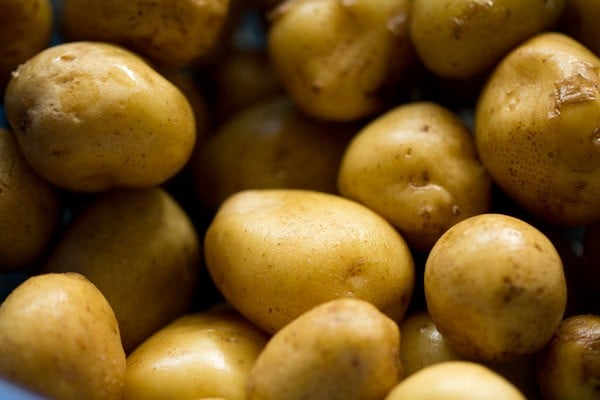
2. Take 3.5 cups water and ¼ teaspoon salt in a pan.
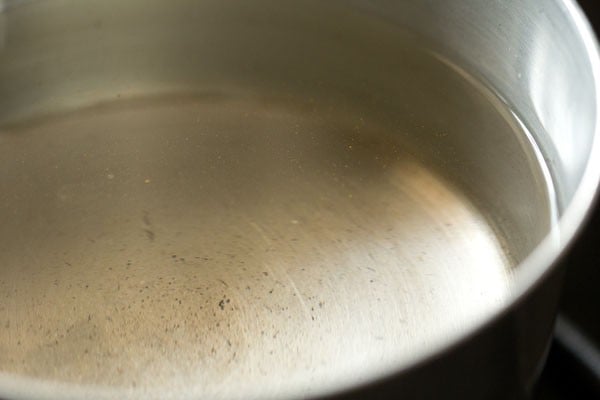
3. Add the potatoes.
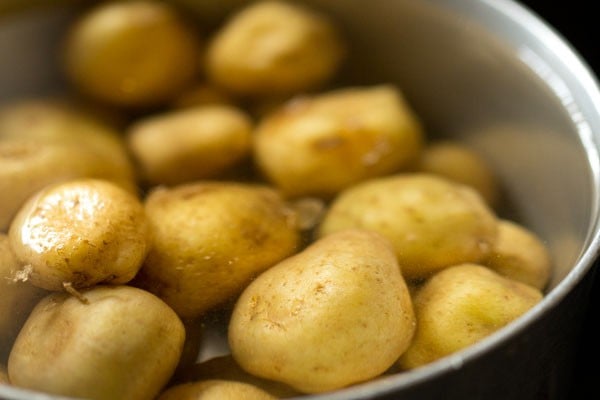
4. On medium to high heat, boil the water so that the potatoes are half-cooked or parcooked. This takes about 9 to 10 minutes.
You can even pressure cook the baby potatoes in 3 cups water for 1 whistle.
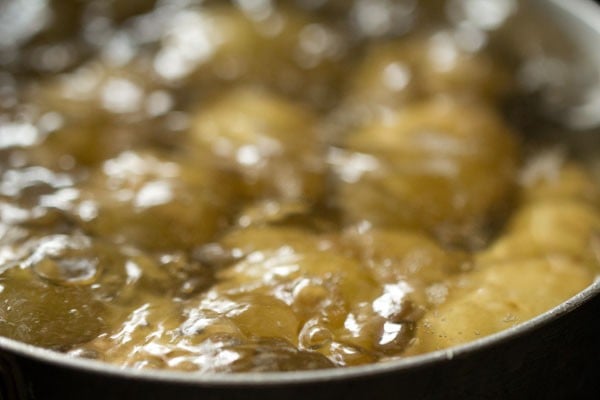
5. Drain the water from the potatoes and allow to become warm or cool down to room temperature.
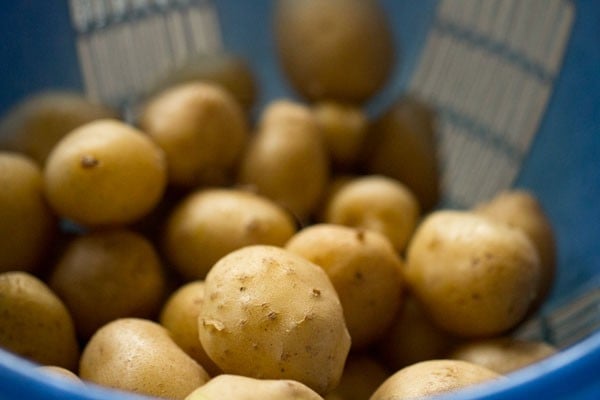
6. Peel the potatoes. This task takes a lot of time. So, do it while listening to music or watching your favorite TV show.
If you want, you can keep the peels too.
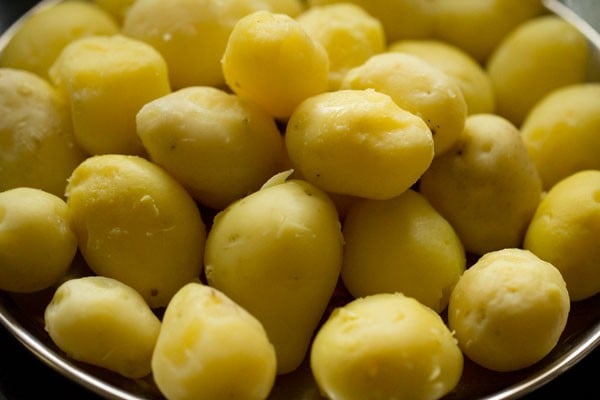
7. With a fork, toothpick or skewer, poke holes in the potatoes all over.
This is done so that when cooking on dum, the potatoes absorb the flavors of the masala in which they are getting cooked.
Halve them, if they are big or you can keep them whole, if they are small and then poke them.
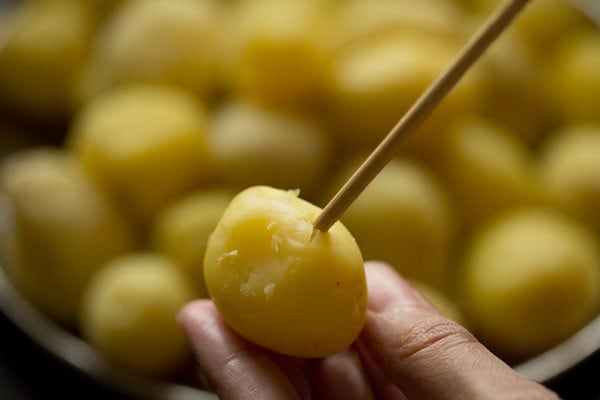
More Preparation
8. Whisk 6 tablespoons fresh full fat curd (yogurt) till smooth. Set aside.
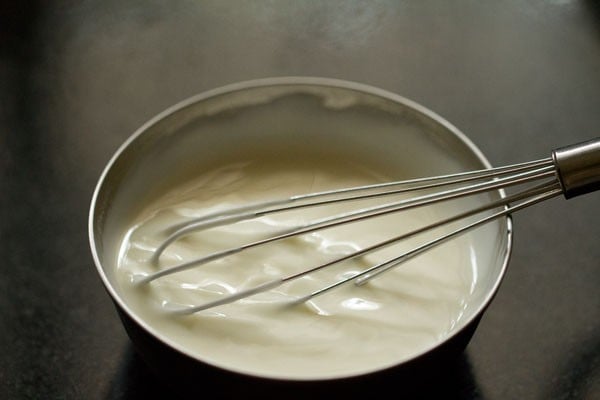
9. In a small bowl, take 1 tablespoon Kashmiri red chili powder and 2 tablespoons water.
For a bright red color and the right amount of spiciness in the dish, I would suggest to use Kashmiri red chilli powder.
Any other variety of red chilli powder, will change the color as well as alter the spiciness in the gravy, depending on the pungency and hotness of the chilli powder.
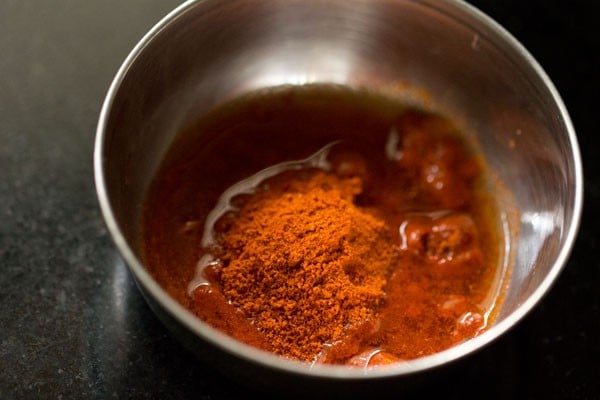
10. Stir and mix well to get a smooth and even mixture without any lumps.
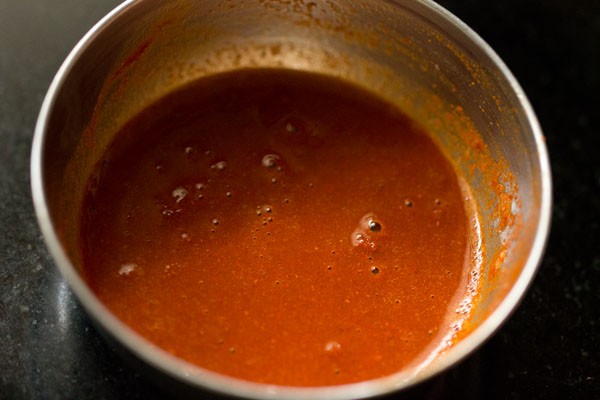
Fry Baby Potatoes
11. In a pan, heat ¾ cup mustard oil till it begins to lightly smoke on medium to medium-high heat.
Add the parboiled peeled baby potatoes and begin to fry them on medium-low to medium heat.
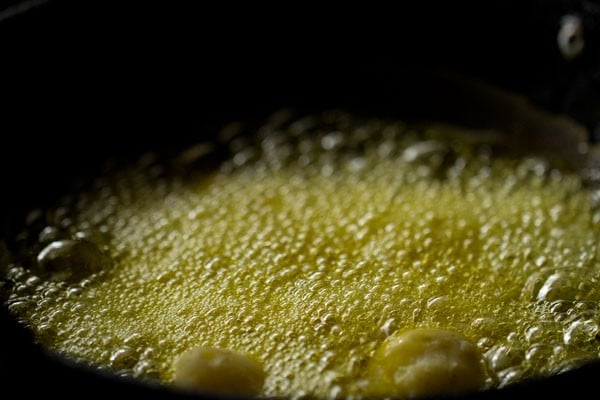
12. With a slotted spoon, turn them over while frying, when one side is golden.
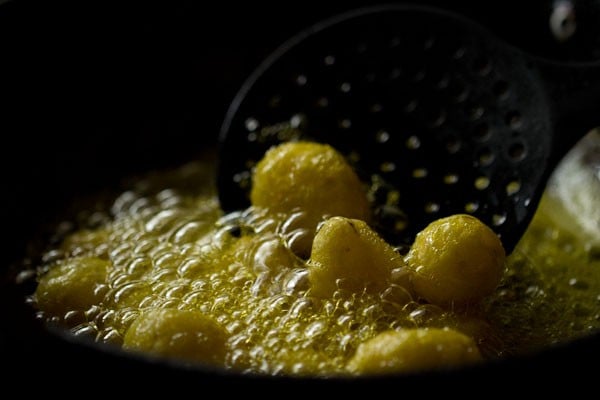
13. Fry the second side until golden. Turn over as needed and fry the baby potatoes until they look crisp and golden.
Remove the baby potatoes which have turned golden and crisp with a slotted spoon. Continue to fry the remaining potatoes until they turn golden.
Since they will be of different sizes, a few smaller ones will get fried faster as compared to the medium-sized ones.
Ensure to fry them well or else they remain uncooked from the center.
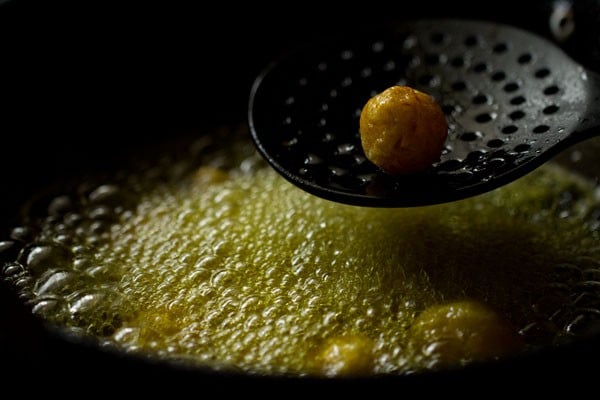
14. Place the fried potatoes on kitchen paper towels to remove excess oil. Fry all the potatoes until golden and crisp, in batches if using a small or medium-sized kadai (wok).
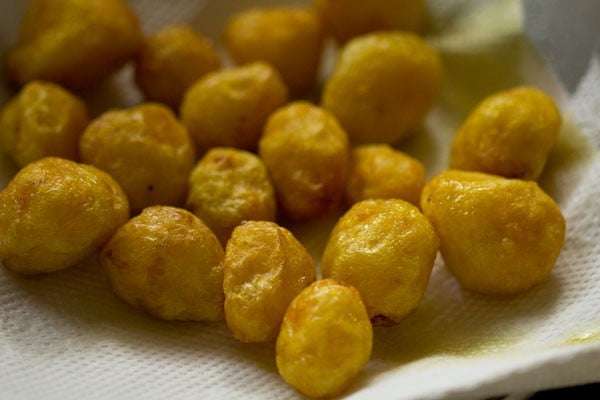
15. If you want, you can again poke holes in the fried baby potatoes. This is an optional step.
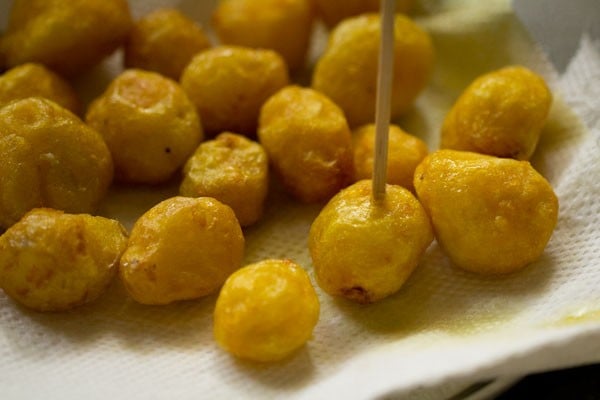
Make Gravy
16. In another pan or kadai heat 2 tablespoons of mustard oil. Keep heat to low or medium-low.
Add a pinch of asafoetida (hing) and stir to combine.
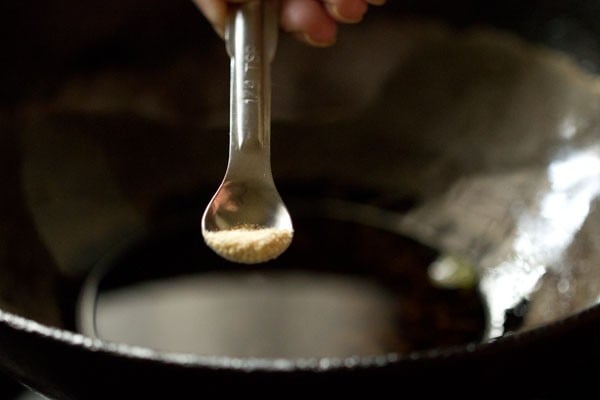
17. Reduce heat to low or turn off the heat. Add the prepared red chilli powder and water mixture. Stir and mix. Be careful as the mixture splutters.
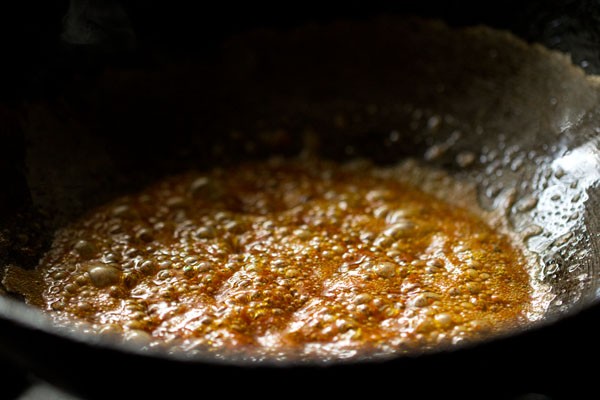
18. With the heat reduced or turned off, next add the beaten curd (yogurt).
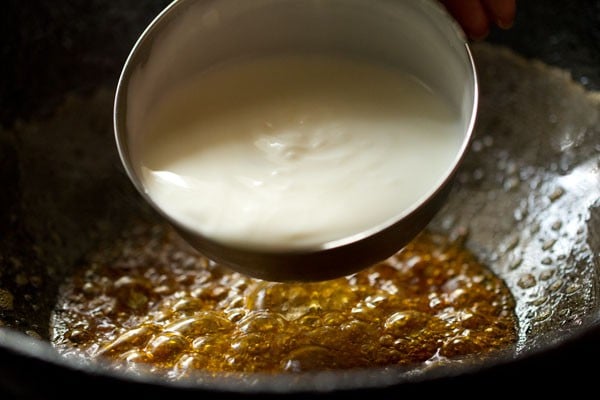
19. As soon as you add the curd, with a spoon or wired whisk, begin to stir continuously so that the curd does not split and separate.
Add the curd on low heat or you can opt to turn off the heat.
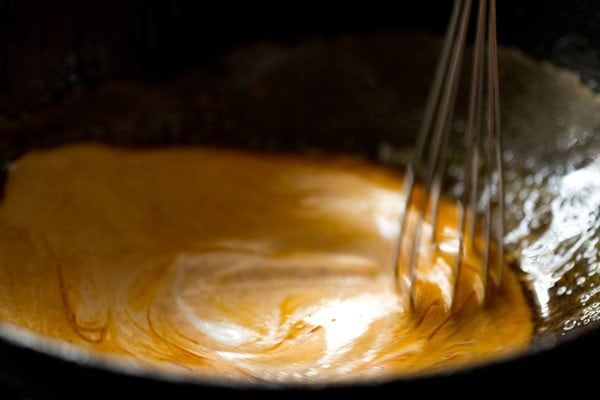
20. Next, add 1¼ to 1½ cups of water and continue to stir. Mix very well.
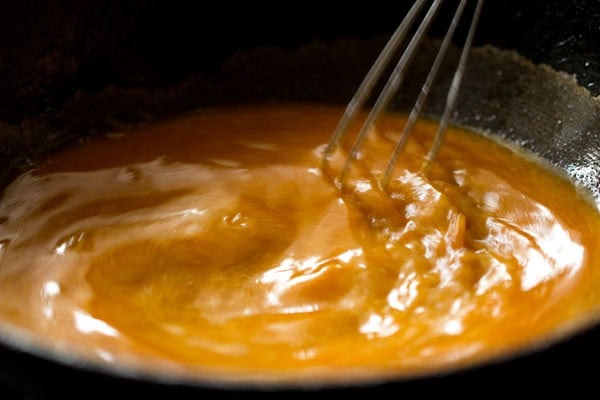
21. Then, add 1 tablespoon fennel (saunf) powder.
If you do not have readymade fennel powder, than you will have to make it. Roast ¾ tablespoon fennel seeds lightly in a small frying pan or griddle. When cooled, then pound in a mortar-pestle to a medium fine to fine powder. You can also grind in a small spice grinder or coffee grinder.
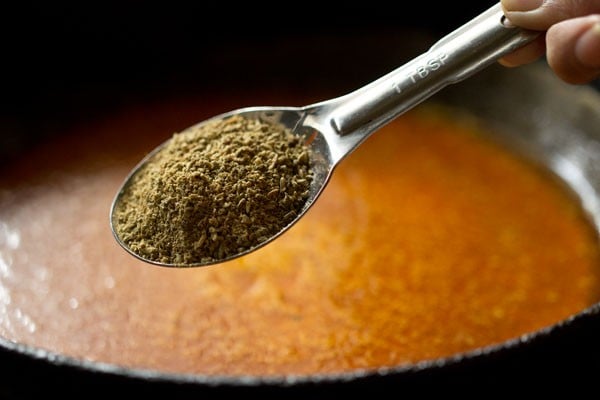
22. Add 1 teaspoon caraway seeds (shahi jeera), 1 inch cinnamon, 3 cloves, 1 black cardamom, 4 to 5 black peppercorns and 1 green cardamom (optional).
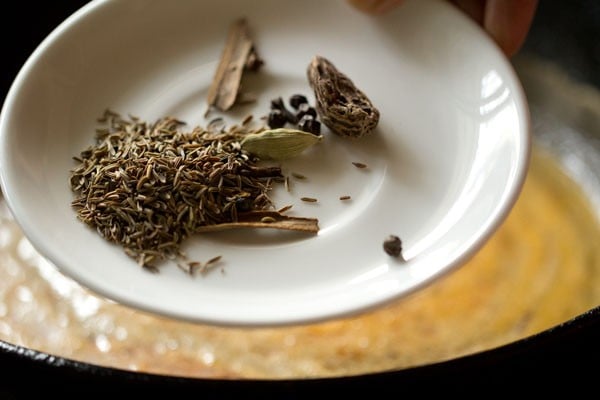
23. Add ½ tablespoon dry ginger powder (saunth/sonth) and mix well.
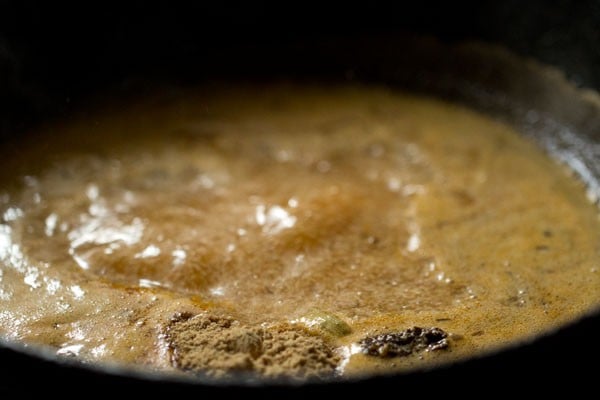
Make Kashmiri Dum Aloo
24. Now, add the fried baby potatoes. Stir and mix again.
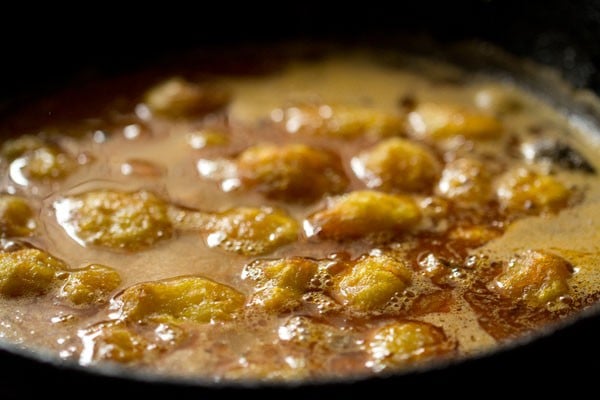
25. Season with salt according to taste. Mix well.
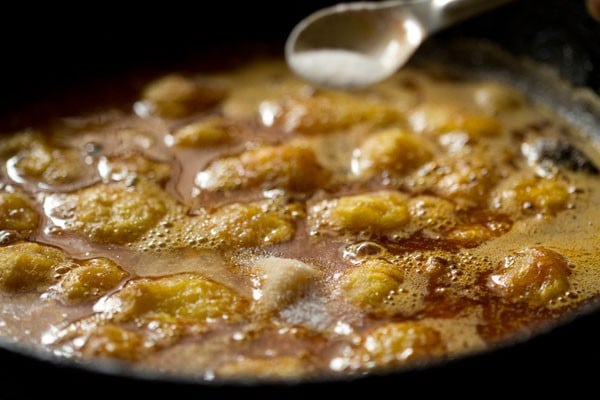
26. Cover the pan tightly with a lid and cook on low to medium heat for 8 to 10 minutes. Here, we are cooking the baby potato gravy on dum.
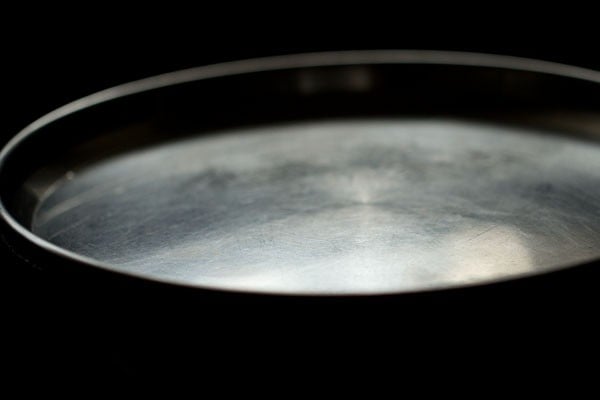
27. The gravy should become thick. You could also make a thicker semi-dry consistency if you prefer.
Remember you can always add less or more water depending on how thick or thin you want the gravy.
Additionally make a note that if you cook for more time, the gravy will reduce more but the potatoes can get overdone and become mushy or fall apart in the gravy.
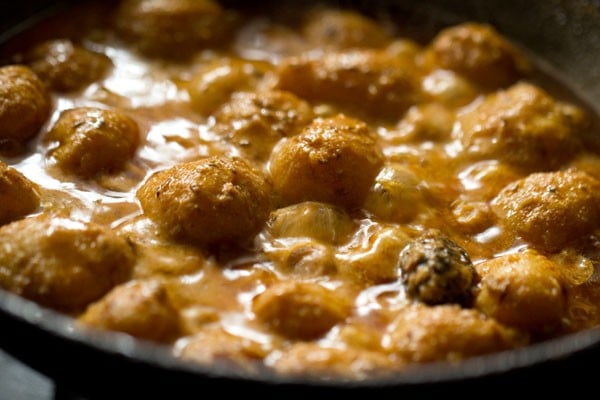
27. Sprinkle 2 to 3 pinches of caraway seeds on top (optional). Serve Kashmiri Dum Aloo hot with steamed basmati rice.
The second-best option is to serve with Indian flatbreads like naan, roti or plain paratha.
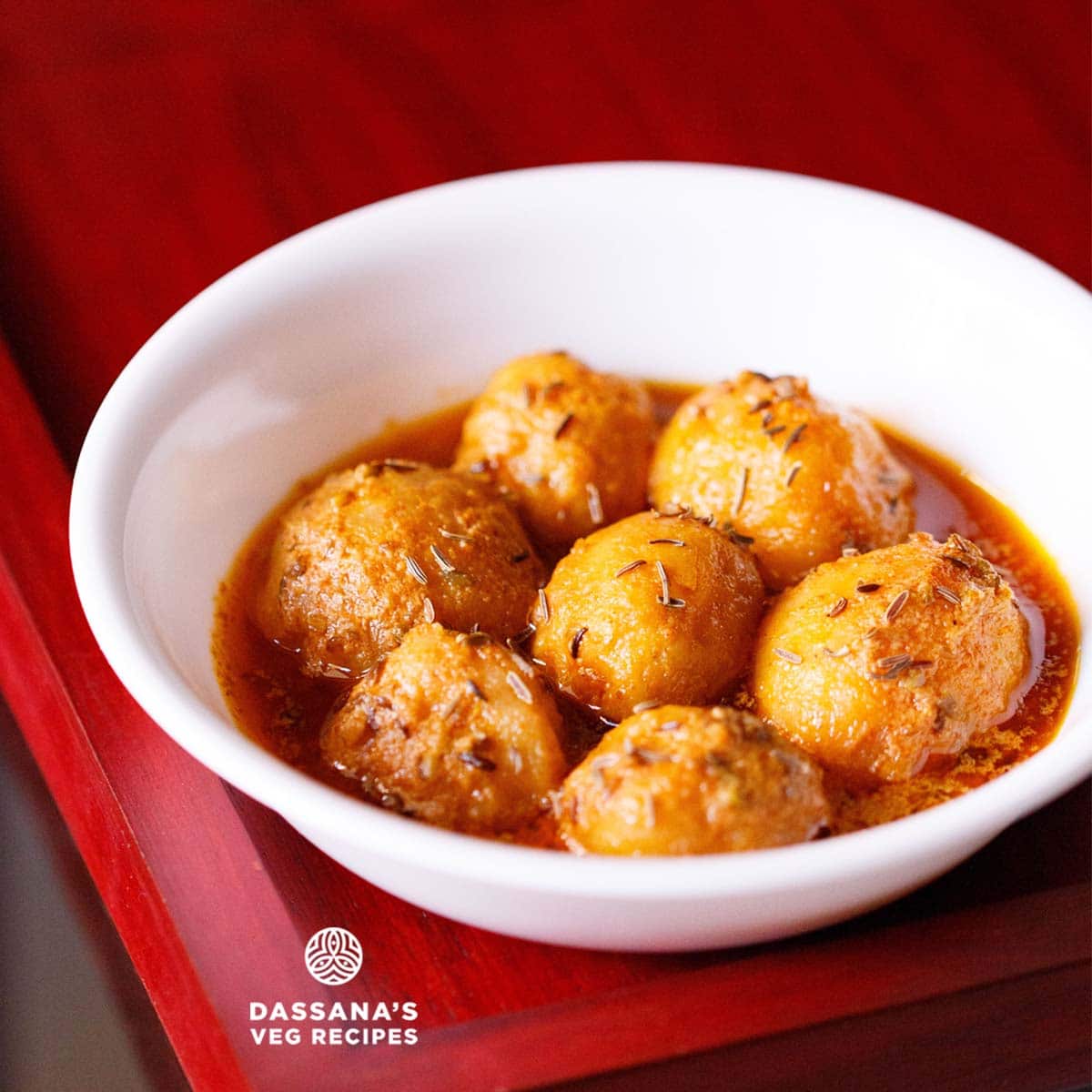
About Kashmiri cuisine
Primarily non-vegetarian, the cuisine of Kashmir is as heavenly as the place itself is. However, it is not just about the non-vegetarian feast that dominates the Kashmiri food culture. There are a variety of vegetarian dishes too that are equally exquisite as well as delicious.
These are a part of the everyday meals for the Kashmiri Pandits of this region. For example, some of the Kashmiri recipes that I have on my blog are majorly vegetarian, like this Kashmiri Dum Aloo, Kashmiri Biryani, Kashmiri Pulao and the quintessential Methi Chaman.
So, it can easily be said that Kashmiri cuisine has influences of both Mughlai cuisine and the cuisine of the Pandits.
A very significant part of Kashmiri cuisine is the tradition of ‘wazwan’ – a multi-course meal consisting of many classic Kashmiri dishes.
Wazwan is a popular form of community feasting that is prepared during special occasions like weddings, etc. and festivals in Kashmir. Some of the highlights are that it usually consists of 36 courses.
Apart from breads, main course curries, a plethora of vegetarian dishes made of fresh greens, etc., Kashmiri cuisine is also known for its unique beverages. Some of the famous ones include tea specialties like the Kahwa and noon chai.
Expert Tips
- Instead of parboiling and frying later, you can even bake/roast or steam the baby potatoes for a healthy twist. You can also opt to boil the potatoes until almost tender but a bit firm. Do not fry them later.
- Use curd or yogurt that is fresh and not very sour or overly tangy. Ensure to use curd made from whole milk.
- Do not make this dish with toned yogurt or low fat curd as these types of curd, may split and separate while cooking.
- For the best taste and flavor, I suggest not to reduce or skip any of the ground spices. Having said that if you are intolerant to spicy foods, reduce the chilli powder and ginger powder by a bit.
- Mix the curd well, as soon as you add in the gravy. Also, while doing so, either lower or turn off the heat.
- To avoid curdling of the curd, you can also add some gram flour (besan) or cornstarch (cornflour) to the curd.
- Usually baby potatoes are used in preparing the dish. But if you do not get baby potatoes, use regular potatoes. Cook the potatoes in a pan with water until parcooked or half-cooked. Once cooled, dice them into chunks and fry.
- Since this dish is rich and spicy, the best time to have it is during monsoons or winters.
FAQs
Since traditional Kashmiri Pandit cuisine is also an important part of the overall Kashmiri cuisine, Dum Olav or Kashmiri Dum Aloo is famous as a veg, no onion and no garlic preparation in that region.
Kashmiri Dum Alu is basically made of baby potatoes that are first parboiled, and then fried and cooked in a rich, spicy curd gravy or sauce. It also essentially uses Kashmiri red chili powder, dried ginger powder and mustard oil as some of the other ingredients.
No. Traditional Kashmiri Dum Aloo is not sweet but hot and pungent.
How is Kashmiri Dum Aloo different from North Indian version?
The most striking difference between the two is that Kashmiri Dum Aloo has no onion or garlic added to it, whereas the North Indian or Punjabi versions usually have onion and garlic in it.
Kashmiri Dum Aloo also classically uses mustard oil whereas the North Indian variations can be cooked in ghee or other vegetable oils.
Also, fresh ginger is added in a North Indian flavored aloo dum whereas dried ginger powder is used in a Kashmiri preparation.
Using a mix of ground spices like fennel powder, asafoetida, ginger powder and an ample amount of Kashmiri red chilli powder together with the yogurt, imparts a complex and unique flavor profile to this dish.
This combination makes it stand out from the richer, creamier, sweet, and spiced North Indian-style versions which contain onions, cashews, tomatoes, cream and spices.
More Baby Potato Recipes To Try!
Please be sure to rate the recipe in the recipe card or leave a comment below if you have made it. For more vegetarian inspirations, Sign Up for my emails or follow me on Instagram, Youtube, Facebook, Pinterest or Twitter.
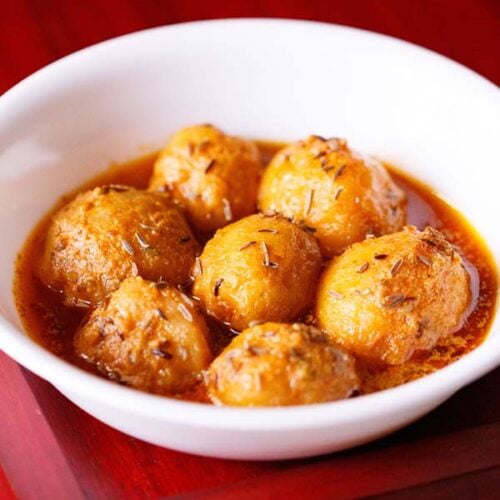
Kashmiri Dum Aloo
Kashmiri Dum Aloo is a flavorful, spicy, tangy and robust recipe of baby potatoes slow cooked in a yogurt based gravy or sauce. The recipe is spicy and made without onion and garlic. This authentic and popular dish from the Kashmiri Pandit cuisine made with baby potatoes fried in mustard oil, includes spices, both whole and ground; together with fresh curd (yogurt).
Prep Time 30 minutes
Cook Time 20 minutes
Total Time 50 minutes
Prevent your screen from going dark while making the recipe
Boiling Potatoes
Rinse the baby potatoes very well in water. Brush or scrub the mud etc from them.
Take 3.5 cups water in a pan. Add the potatoes.
On a medium to high heat boil the water, so that the potatoes are half-cooked.
Drain the water and let the par-cooked potatoes become warm or cool at room temperature.
- Peel the potatoes. This task takes a lot of time, so do it while listening to music or watching your favorite tv show. If you prefer you can keep the peels too.
- With a fork, tooth pick or skewer, poke holes in the potatoes all over. Halve them or you can keep them whole if they are small. This is done so that when cooking on dum, the potatoes absorb the flavors of the masala in which they are getting cooked.
Whisk the fresh full-fat curd or yogurt till smooth. Keep aside.
In a small bowl, take kashmiri red chili powder and 2 tablespoons water.
Mix and stir well to get a smooth and even mixture.
Frying potatoes
In a pan heat mustard oil on medium to medium-high till it begins to lightly smoke.
Add the parboiled peeled potatoes and begin to fry them on a medium-low to medium heat.
With a slotted spoon, turn them over while frying, when one side is light golden. Fry the second side until golden.
Fry the potatoes until they are evenly golden and crispy. Turn over as needed while frying.
- Remove the potatoes which are golden and crispy with a slotted spoon and continue frying the remaining potatoes which still need to become crispy and golden. Fry the potatoes well or else they remain uncooked from the center.
Place the fried potatoes on kitchen paper towels. Fry all the potatoes until golden and crisp.
If you want you can again poke holes in the fried potatoes. This is an optional step.
Making kashmiri dum aloo
Heat 2 tablespoons mustard oil in another pan on low to medium-low heat.
When the oil is lightly hot, add the red chili + water mixture and stir well. Be careful as the mixture splutters.
- Next, reduce heat to a low and add the beaten curd. When you are adding the curd, stir it continuously with a spoon or wired whisk in the pan, so that the curd does not split.Add the curd on a low heat or turn off the heat.
After adding curd, add water and continue to stir and mix to get an even mixture.
Next add the fennel powder
Add the whole spices and ginger powder. Stir and mix well.
Now add the fried baby potatoes. Again stir to combine.
Season with salt and mix again.
Cover the pan tightly with a lid. Cook for 8 to 10 minutes on a low to medium-low heat.
The gravy should become thick.
- You can always opt to add less or more water depending on how thick or thin you want the gravy. Additionally make a note that if you cook for more time, the gravy will reduce more but the potatoes can get overdone and become mushy or fall apart in the gravy.
Sprinkle the caraway seeds from top (optional) and serve Kashmiri Dum Aloo hot with steamed rice.
- For the best taste and flavor, I suggest not to reduce or skip any of the ground spices. Having said that if you are intolerant to spicy foods, reduce the chilli powder and ginger powder by a bit.
- The baby potatoes could also be baked/roasted or air-fried or steamed instead of parboiling and later frying them.
- If you do not have ready fennel powder than you have to make it. Roast the fennel lightly on a pan or tava. When cooled, then in a mortar & pestle pound the roasted fennel seed to a medium fine powder. You can also grind in a small spice grinder or coffee grinder.
- You could also use the same mustard oil that was used to fry the baby potatoes for making the gravy. Switch off the heat after frying the potatoes. Let the oil temperature reduce. Turning off the heat brings down the oil temperature. Carefully remove the extra oil using a spoon and keep 2 tablespoons oil in the same kadai or pan.
- It is best to have this dish in the winters and rainy seasons.
- Quality of the curd matters. Always use full-fat curd or curd made from whole milk.
- Remember that as soon as you add the curd to the pan, mix it quickly.
- Additionally, when you are adding and mixing the curd, lower the heat or turn off the stovetop.
- Optionally you can add some cornstarch or gram flour (besan) to the curd so that it does not curdle or separate in the gravy.
Nutrition Facts
Kashmiri Dum Aloo
Amount Per Serving
Calories 513 Calories from Fat 288
% Daily Value*
Fat 32g49%
Saturated Fat 5g31%
Polyunsaturated Fat 6g
Monounsaturated Fat 17g
Cholesterol 8mg3%
Sodium 703mg31%
Potassium 1322mg38%
Carbohydrates 53g18%
Fiber 9g38%
Sugar 5g6%
Protein 9g18%
Vitamin A 967IU19%
Vitamin B1 (Thiamine) 0.2mg13%
Vitamin B2 (Riboflavin) 0.2mg12%
Vitamin B3 (Niacin) 3mg15%
Vitamin B6 1mg50%
Vitamin B12 0.2µg3%
Vitamin C 51mg62%
Vitamin D 0.1µg1%
Vitamin E 1mg7%
Vitamin K 9µg9%
Calcium 191mg19%
Vitamin B9 (Folate) 45µg11%
Iron 4mg22%
Magnesium 98mg25%
Phosphorus 238mg24%
Zinc 2mg13%
* Percent Daily Values are based on a 2000 calorie diet.
Kashmiri Dum Aloo from the archives was first published on April 2012.

